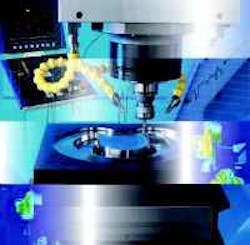Stop Babysitting High-Speed Machines
Machine-monitoring modules make unattended high-speed machining reliable.
Using various machine-mounted modules, Mikron's Smart Machining technology boosts the reliability of unmanned, high-speed machining operations.
Besides its module that automatically compensates for a spindle's thermal drift, Mikron is working on one for 5-axis-machine thermal deviations, such as those generated at a rotary-tilt table's rotating and tilting points.
Unexpected factors such as centrifugal force, unbalance, vibration, thermal expansion, and more come into play when machining centers run at high speeds. Compensating for such negative affects typically requires operators plant themselves at machines and manually adjust cutting parameters. While this practice works, it does put a damper on running high-speed machines unmanned for lights-out operations.
However, one machine tool builder, Mikron of Lincolnshire, Ill., is improving the reliability of unmanned, high-speed machining operations through technology it calls "Smart Machining." The technology involves various machine modules monitoring and recording spindle vibrations, automatically compensating for thermal deviations, optimizing machine processes, and providing remote notification for real-time control/access from any location.
Mikron's modules are the Advanced Process System (APS), Intelligent Thermal Control (ITC), Operator Support System (OSS), and Remote Notification System (RNS). They all work automatically and incorporate a mix of different hardware and software. According to Mal Sudhakar, vice president of Mikron, the company's intent is not to make high-speed machines faster, but instead increase their reliability and optimize cutting performance to eliminate manual intervention for the company's HSM line of machining centers.
In the APS module, a sensor integrated in the machine's spindle near the front bearings measures vibration. These measurements, as an acceleration value G, transmit to the machine's control that displays vibration levels. Operators set safe G-value limits, and when machines exceed these, APS either issues a warning or automatically stops the machine and spindle to protect them from damage during unmanned operations.
Vibration levels range from 0 to 10 G. Values from 0 to 3 G indicate a good/safe process, tool, and toolholder. Those from 3 to 7 G require operators adjust the process so they don't shorten spindle/tool life, while values from 7 to 10 G tell shops that continuing in that range damages spindles, machines, tools, and workpieces. The APS module displays these ranges as green, yellow, and red.
The module also records measured vibrations for analysis. All recorded data that exceeds set G limits includes actual date, time, value of G, G limit, actual rpm, tool number, feedrate, NC-block number, and NC-program name. With this information, shops can optimize particular NC programs.
APS's file log holds 18,000 recordable blocks. With a time interval of 2.5 sec, the system records 12.5 hr of milling time over set G limits.
In addition to the APS module, Mikron is developing technology that predicts spindle failure by monitoring bearings and input/output. Such a system indicates a spindle's remaining work life and when to change its bearings.
For thermal control, Mikron's ITC module uses spindle-mounted temperature sensors that send data to a software module that then automatically compensates for thermal drift caused by increased centrifugal forces in high-speed machining. Such compensation not only ensures workpiece accuracy, it means operators don't have to adjust for spindle warm-up and rpm changes. According to Sudhakar, operators turn on machines and run them as if they're already warmed up.
A catalogue of software algorithms in the ITC module predicts a spindle's thermal drift at any speed and at various points in time. It keeps Z-axis thermal drift within a 20-µ bandwidth without warm-up or preheat cycles. When shops do run warmup cycles in which both spindle and tooling thermally stabilize, the module controls thermal drift to within a 10-µ bandwidth.
Besides its ITC module, Mikron is working on one that automatically compensates for thermal deviations in 5-axis machines. For instance, it does so for heat generated at a rotary-tilt table's rotating and tilting points.
While the APS and ITC modules are most popular among end users and come standard on Mikron machines, shops shouldn't discount the benefits of the OSS and RNS modules for improving unmanned high-speed operations. OSS optimizes milling processes relative to specific applications by modifying hidden and usuallyinaccessible parameters of machine-performance settings. It prioritizes three target values: speed, accuracy, and surface finish.
For example, Makino's moldmaking end users often rough cut molds at the fastest machining times possible, with accuracy and surface finish not as strong a concern. While other shops, such as those finish cutting high-precision EDM electrodes or finishing blow molds, need accuracy and good surface finishes, respectively. For all these shops, the OSS module lets them select one, two, or all three of the target values, and it then automatically dictates corresponding parameters to the machine's control.
The machine monitor displays a triangle having speed in one corner, accuracy in another, and surface finish in the third. Using a tracking ball, operators highlight any of these individual settings or the middle of the triangle to emphasize all three.
Through a GSM modem connected to a machine's RS-232 port, Mikron's RNS module lets shops communicate with high-speed machines running unattended during nights and weekends. The hook-up sends signals and text messages to any cell phone, and shops can set the module's software to notify specific personnel when particular error types occur. It can also contact individuals concerning signals from the other three modules.
Users list persons needing to be informed in an address file on the machine's control. In addition, they can define the types of information to be communicated, such as machine stoppages, errors, and warnings.
